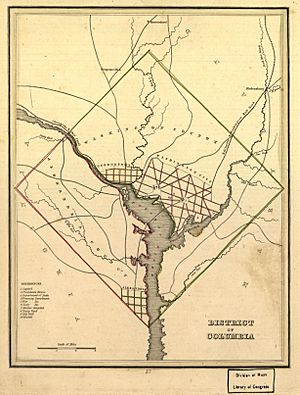Washington County, D.C. facts for kids

The County of Washington was one of five original political entities within the District of Columbia, the capital of the United States. Formed by the Organic Act of 1801 from parts of Montgomery and Prince George's County, Maryland, Washington County referred to all of the District of Columbia "on the east side of the Potomac, together with the islands therein." The bed of the Potomac River was also considered to be part of Washington County.
Originally Alexandria County, D.C. formed the portion of the District west of the Potomac River, ceded by the commonwealth of Virginia. Alexandria County, including the City of Alexandria, was returned to Virginia by Congress in 1846, leaving just Washington County. Within Washington County there were two incorporated areas, the City of Washington and the City of Georgetown. At times the rural parts outside of the cities were referred to as "Washington County" but all three were part of the county. Upon the passage of the District of Columbia Organic Act of 1871, the three governments were unified under a single District government and made coterminous, ending Washington County's separate identity.
History
| Population in County outside cities | ||
|---|---|---|
| Year | Pop. | ±% |
| 1800 | 1,941 | — |
| 1810 | 2,315 | +19.3% |
| 1820 | 2,729 | +17.9% |
| 1830 | 2,994 | +9.7% |
| 1840 | 3,069 | +2.5% |
| 1850 | 3,320 | +8.2% |
| 1860 | 5,225 | +57.4% |
| 1870 | 11,117 | +112.8% |
| Source: | ||
Rural Washington County, the part outside of the cities, included Pleasant Plains, the estate of the Holmead family; Edgewood, home of Treasury Secretary Salmon P. Chase; and Petworth, the estate of Colonel John Tayloe III. Also contained in rural Washington County was the U.S. Soldiers' Retirement Home, where President Abraham Lincoln lived during his summers as president. Despite its comparatively large geographic size, rural Washington County was sparsely populated until the end of the 19th century.
Slavery was legal in Washington County, as it was in Maryland, but it was illegal to import a slave from Alexandria County for sale in Washington County. Slavery was ended in Washington County in April 1862 by the District of Columbia Compensated Emancipation Act. Except for the abolition of slavery by the unionist "Restored Government of Virginia" in April 1864, the DC Emancipation Act was the last part of the United States to end slavery before the 13th Amendment ended it throughout the country.
During the American Civil War (1861–65), Washington County contained a partial circle of defensive fortifications that made Washington one of the most heavily fortified cities in the world at that time. The forts surrounding Union-held territory in Virginia completed the defense circle. The Battle of Fort Stevens, July 11–12, 1864, took place in Washington County.
After the Civil War, many of the old estates in Washington County were sold and developed into suburbs for the growing capital city. Among the earliest developments were LeDroit Park and Mount Pleasant, which eventually became the first "streetcar suburb". Uniontown and Barry Farm, a settlement for freedmen, developed east of the Anacostia River.
Washington County and the cities of Washington and Georgetown were abolished in 1871 following the passage of the District of Columbia Organic Act of 1871. This law brought the entire District of Columbia under the control of a territorial government headed by an appointed governor, an appointed eleven-member council, and a locally-elected 22-member assembly. Two of the eleven council seats were reserved for representatives from the District outside of the cities of Washington and Georgetown. Three years later, Congress abolished the territorial government in favor of direct rule over the District by an appointed three-member commission.

